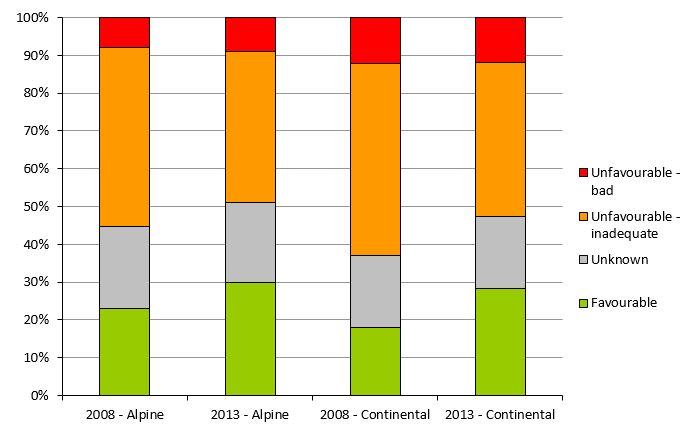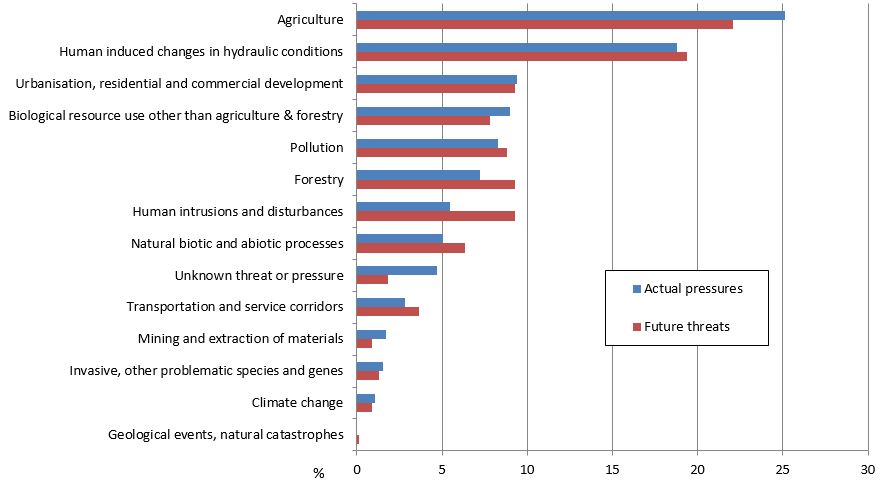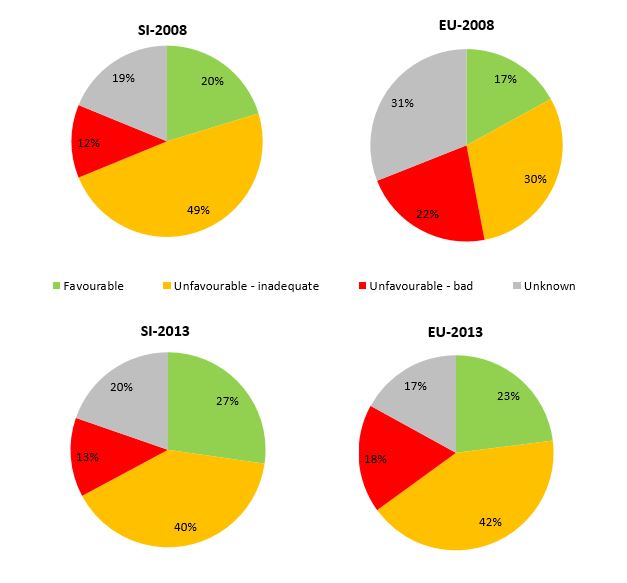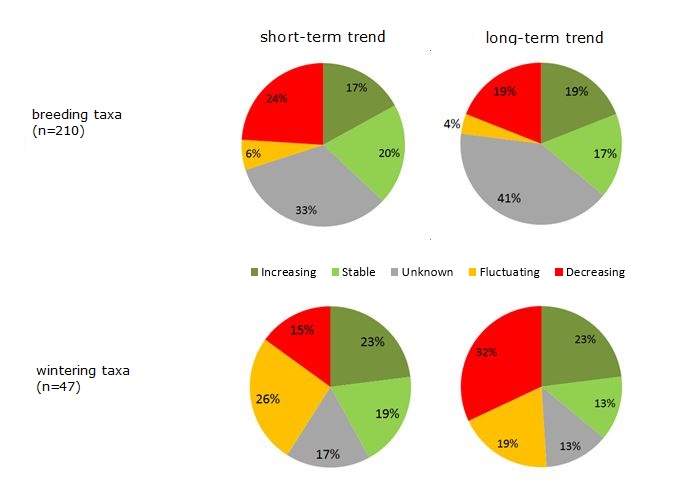[NB11] Species of European interest

Key message

The conservation status of species in Slovenia shows that only about a quarter of species’ show a favourable status. Furthermore, the trends are unfavourable. Even though the proportion of species showing a favourable conservation status increased in the period 2008–2012, the proportion of species showing a poor conservation status also increased. In order to achieve the objectives of the strategy, its guidelines must be consistently taken into account, while the adopted programmes and management plans of protected areas must be implemented.
Definition
This indicator follows the conservation status of species of European interest. These include the species from the Habitats Directive (Council Directive 92/43/EEC), as listed in Annexes II, IV and V. The indicator is used to assess whether:
- the data on the population dynamics of a certain species indicate that it is capable of maintaining itself on a long-term basis on its own in its natural habitat;
- the natural range of a certain species is not being reduced nor is it likely to be reduced in the future;
- a large enough habitat exists (and will continue to exist) for the long-term conservation of populations of a certain species.
The conservation status of a species is thus used to measure impacts on an individual species, which can have a long-term effect on the size and distribution of its populations.
Charts
Reports under Article 17 on the conservation status of habitats and species under the Habitats Directive for the period 2004 – 2006 and 2007 - 2012, Ministry of the Environmet and Spatial planning, Institute of the Republic of Slovenia for Nature Conservation, 2013
| 2008 - Alpine | 2013 - Alpine | 2008 - Continental (183) | 2013 - Continental | ||
|---|---|---|---|---|---|
| Favourable | number | 35 | 44 | 33 | 50 |
| Unknown | number | 33 | 31 | 35 | 34 |
| Unfavourable - inadequate | number | 72 | 59 | 93 | 72 |
| Unfavourable - bad | number | 12 | 13 | 22 | 21 |
Reports under Article 17 on the conservation status of habitats and species under the Habitats Directive for the period 2004 – 2006 and 2007 - 2012, Ministry of the Environmet and Spatial planning, Institute of the Republic of Slovenia for Nature Conservation, 2013
| Favourable | Unfavourable - inadequate | Unfavourable - bad | Unknown |
|---|
Reports under Article 17 on the conservation status of habitats and species under the Habitats Directive for the period 2004 – 2006 and 2007 - 2012, Ministry of the Environmet and Spatial planning, Institute of the Republic of Slovenia for Nature Conservation, 2013
| Actual pressures | Future threats | ||
|---|---|---|---|
| Agriculture | % | 25 | 22 |
| Forestry | % | 7 | 9 |
| Mining and extraction of materials | % | 2 | 1 |
| Transportation and service corridors | % | 3 | 4 |
| Urbanisation, residential and commercial development | % | 9 | 9 |
| Biological resource use other than agriculture & forestry | % | 9 | 8 |
| Human intrusions and disturbances | % | 5 | 9 |
| Pollution | % | 8 | 9 |
| Invasive, other problematic species and genes | % | 2 | 1 |
| Human induced changes in hydraulic conditions | % | 19 | 19 |
| Natural biotic and abiotic processes | % | 5 | 6 |
| Geological events, natural catastrophes | % | 0 | 0 |
| Climate change | % | 1 | 1 |
| Unknown threat or pressure | % | 5 | 2 |
Reports under Article 17 on the conservation status of habitats and species under the Habitats Directive for the period 2004 – 2006 and 2007 - 2012, Ministry of the Environmet and Spatial planning, Institute of the Republic of Slovenia for Nature Conservation, 2013
State of nature in the EU – results from reporting under the nature directives 2007-2012. EEA Technical report No 2/2015.
| Favourable | Unfavourable - inadequate | Unfavourable - bad | Unknown | ||
|---|---|---|---|---|---|
| Slovenia | number | 41 | 98 | 25 | 38 |
| Slovenia | % | 20 | 49 | 12 | 19 |
| EU - 25 | % | 17 | 30 | 22 | 31 |
Reports under Article 17 on the conservation status of habitats and species under the Habitats Directive for the period 2004 – 2006 and 2007 - 2012, Ministry of the Environmet and Spatial planning, Institute of the Republic of Slovenia for Nature Conservation, 2013
| Short-term trend 2001 - 2012 | Long-term trend 1980 - 2012 |
|---|
Reports under Article 17 on the conservation status of habitats and species under the Habitats Directive for the period 2007 - 2012, Ministry of the Environmet and Spatial planning, Institute of the Republic of Slovenia for Nature Conservation, 2013
| Breeding taxa - short-term trend | Breeding taxa - long-term trend | Wintering taxa - short-term trend | Wintering taxa - long-term trend |
|---|
Goals
- To maintain a favourable status of all autochthonous animal and plant species (Strategy – SI);
- To halt the deterioration of the status of all species covered by EU nature protection legislation and to achieve a significant and measurable improvement of their status so that by 2020, 50% or more species assessments conducted in accordance with the Habitats Directive have reached a favourable conservation status or shown a significant improvement in their status compared to the present assessments. (Strategy – EU)
Comment
The conservation status of most species of European interest in Slovenia is unfavourable. Only 27% of species (which is 4% more than in the EU as a whole), were assessed as having favourable conservation status. Compared to 2008, the share of species whose status was assessed as favourable increased by 7%. However, the share of species whose status was assessed as poor increased as well. The main reason for unfavourable conservation status in Slovenia is loss of habitat, caused by humans through unsustainable management and spatial development. Due to inappropriate agricultural practices and anthropogenic impacts on the aquatic ecosystem, the worst conservation status has been found among arthropod species (crustaceans, butterflies, beetles and dragonflies), amphibians and fish. The trend for these species is also unfavourable. Favourable conservation status has been observed mostly in species' belonging to ferns and seed-bearing plants (>50 %).
Compared to Slovenia, the conservation status of species at the EU level is somewhat worse. 18% of species have been found to have poor status. Like in Slovenia, the share of species assessed to be of favourable conservation status has increased over the last six years. For a fifth of species in Slovenia (3% more than at the EU level), conservation status has not been assessed due to a lack of data.
More than one fifth of populations of song birds of European interest in Slovenia have a negative short-term and/or long-term trend. 38% of populations have a stable or positive short-term trend, while 35% of populations have a stable or positive long-term trend. One fourth of breeding populations have a negative short-term trend and one fifth has a negative long-term trend. One third of wintering populations in Slovenia have a negative long-term trend, while a negative short-term trend was determined for only 15% of populations.














